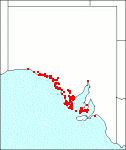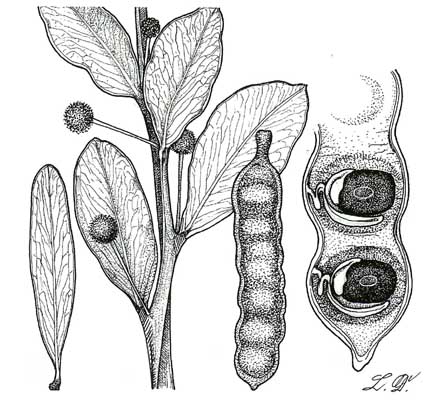Family: Fabaceae
Acacia anceps
Citation:
A. P. de Candolle, Prodr. 2:451 (1825), Mem. Leg. 446 (1826-1827),
Derivation: anceps (L.)—two edged, refers to the flattened angled stems.
Synonymy: Acacia anceps, Acacia glaucescens, Acacia muelleri, Acacia pterigoidea Common name: None
Description:
Erect, rigid, glabrous, spreading shrubs 1-3 m high, the same or more across, branching from the ground; branchlets compressed or flattened and very acutely angled or winged.
Phyllodes linear oblong, narrow obovate, broadly ovate-oblong oblique 1-5 cm long, 1-3.5 cm broad, thick rigid often undulate, glaucous, broad-based with the lower edge continuous and decurrent with the stem, or with a short pulvinus, 1-veined with numerous fine lateral veins, margins thickened and vein-like. Glands either basal or near middle on upper margin.
Inflorescences axillary and solitary; flower-heads globular large, deep golden yellow, c. 40-flowered; peduncles stout 1-2.5 cm long; flowers 5-merous.
Legumes stipitate flat often undulate, straight or curved, 3-5 cm long, 10-12 mm broad, coriaceous, wrinkled or marked with prominent transverse lines; margins thickened vein-like. Seeds transverse in legume; funicle long, folded under the seed then 1/2 or more encircling the seed in a double fold, thickening into a small aril.
|
|
Distribution:
|
S.Aust.: NU, EP.
|
Flowering time: September — February (mainly summer months).
|

SA Distribution Map based
on current data relating to
specimens held in the
State Herbarium of South Australia
|
Biology:
No text
Taxonomic notes:
A. anceps is a food plant for the larvae of the butterfly Jalmenus icilius, Fischer (1978).
Maslin & Whibley (1987) give an enlarged description of A. anceps, an account of its synonyms and possible hybrids as well as a key to A. anceps and its related species.
Cultivation:
These varieties are useful for planting in coastal areas as they branch close to the ground and have thick leathery phyllodes which are able to withstand the wind; they can be planted as a hedge plant. Also suitable for inland planting. Moderate growth rate.
Author:
Not yet available
Source:

|

